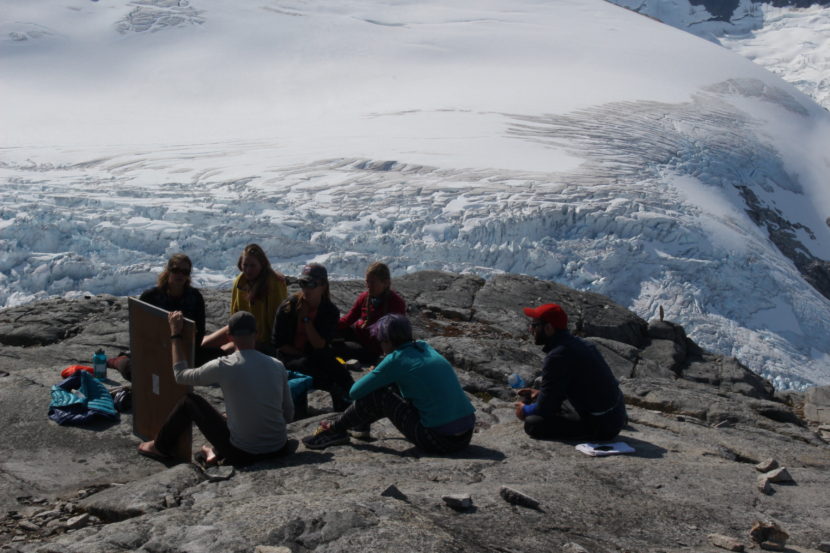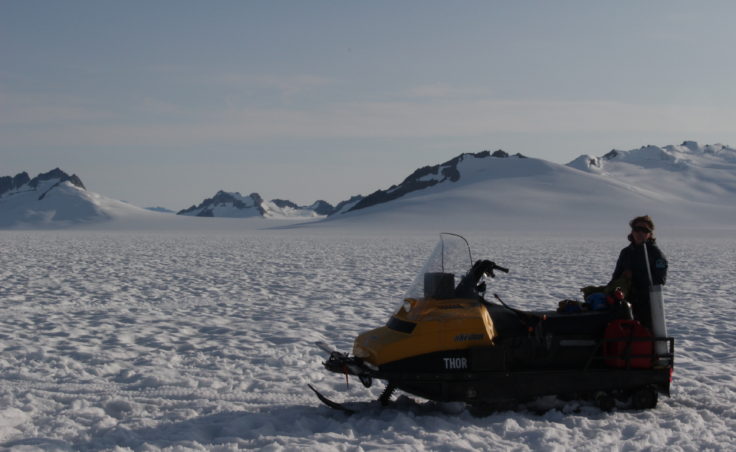Every year, dozens of 20-somethings forego a summer break to live on the Juneau ice field. They slog heavy packs and ski to camps — miles away from the closest cell phone signal or Wi-Fi hotspot. The Juneau Icefield Research Program has been around for 70 years. First, exploring the icy expanse. And later, tracking the rate Southeast glaciers are shrinking.
If you squint, you might think you’re in the desert. Flat, white terrain stretches out as far as the eye can see and rocky peaks dot the horizon. The people, too, appear to be dressed for warm weather. Most are wearing running shorts and t-shirts. Their eyes hidden behind sunglasses to block the glare from snow.
Olivia Truax — a recent graduate from Amherst College — says she can’t imagine her peers would be up for the Juneau ice field.
“Probably not,” she said. “One of my friends was dropping me off at the airport and she was like, ‘you’re off to spend your summer on the ice doing science and skiing and digging. That sounds like my personal hell. Have fun!’”
But Truax and the others are clearly having a good time. They’re digging a hole in the snow that’s so deep they had to develop a special strategy. Rather than dropping straight down, the pit resembles a Tetris piece. And working together, each person shovels the snow and ice onto the next platform. This isn’t boot camp. This is science.
By the end of the day, they’ll reach last year’s snow surface which will allow them to measure how much snow is above it and determine how much the ice field is gaining or losing.
“With some fancy math and weather data, we can figure out how much snow can be left,” said Annika Ord, a Southeast resident who’s on safety staff.
The program has the oldest mass balance record in North America. A record of how the Juneau icefield — which feeds more than 30 major glaciers — is changing.
Miles away from the snow pit is Camp 18. It’s a rustic collection of bunkhouses where students and scientists live during their stay. And it feels like it’s on the top of the world. On a clear day, you can see where glaciers meet and flow down the valley.
Like Olivia Truax, you would expect most of the people who attend this program to describe themselves as “outdoorsy” but not Joel Gonzalez-Santiago.
“No, not even a little bit,” he said.”I prefer to be indoors with my computer and maybe some nice music, in a controlled temperature.”
Gonzalez-Santiago is a junior at Elizabeth City State University in North Carolina and a business major. He learned about the program through an academic adviser and decided to give it a shot.
He’s logged a lot of firsts: First time camping overnight, first time seeing skis, first time traveling long distances on skis.
“Back at home, I walk a total of maybe a mile?” said Gonzalez-Santiago. “And that’s to get from my house to the car, to the car to the parking lot and to school. So, it’s different. I’ve never done anything like this before.”

To get to the 1,500 square mile ice field, students take a trail behind Juneau’s Home Depot. The multi-day trek involves hiking up steep terrain, climbing and eventually skiing on top of glaciers. Gonzalez-Santiago says to get through it, he had to get out of his own head. But he doesn’t regret spending his summer on ice.
He’s excited to send photos of his goggle tan and the landscape back to his grandma in Puerto Rico. And explain to his family what climate change means. That some of the glaciers, where he just spent two months, are disappearing.
“Yeah, I can show them and say, ‘I’ve witnessed this. I see it. You can’t deny it.’” he said.
This summer, the youngest person on the icefield is fresh outta high school. And the oldest person?
“Well, I won’t tell you that,” said Alf Pinchak.
He’s been coming up here since the 1960s. He says when he was a research fellow with the National Science Foundation, it was glacial streams, not human-caused climate change that caught his attention. Pinchak now helps maintain a project that measures the year-round temperature at some of the camps. And he doesn’t think this will be his last trip.
“If you read through the Robert Service poems about this kind of country, I think you’ll come to understand why people come back here: ‘it’s the great big broad land up yonder, it’s the forest where service has lease, it’s the beauty throws me with wonder, it’s the stillness that fills me with peace.’”
Back at the dig, the group has carved out a pit in the snow that’s at least as deep as a few flights of stairs. It’s hours of labor but Olivia Truax doesn’t seem to mind. She says it’s a cool feeling to contribute to such a long-running record.
“But also can be kind of sad when I think about the way our models say the Juneau ice field will be in another 70 years,” she says.
Truax imagines — for her own kids someday — the icefield will be a different and far more dangerous place.

